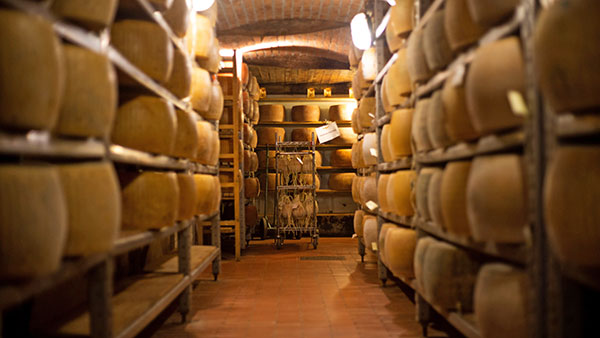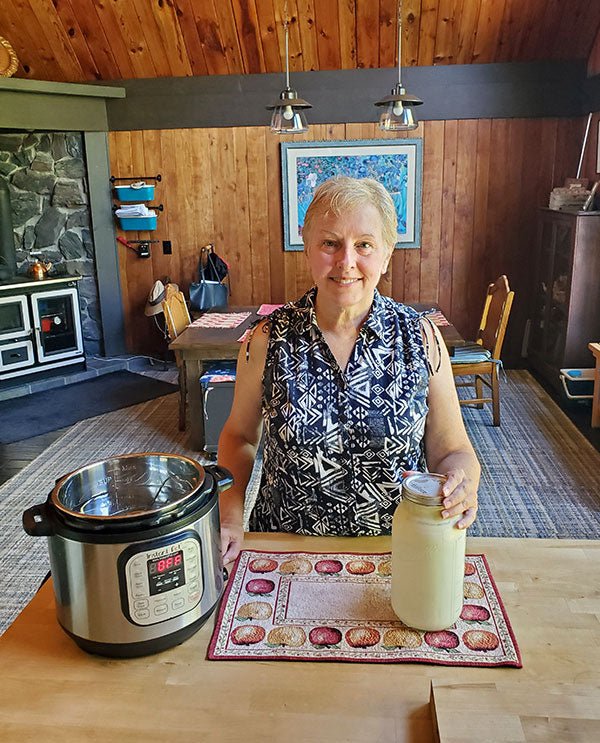
Part of the group (with Castelmagno cheese) in front of a dairy high in the Italian Alps. Yoel is the 4th in (from right to left).
We first interviewed Yoel Blumberger of Tel Aviv, Israel in 2019. (click here) Since then, he has contributed 6 articles, including this one, to our blog and we are eternally grateful.*
This article is the first of 3 interrelated articles by Yoel. The second article is Camembert de Normandie AOP and the Flocculation Point Method and the third is The Role of Cheese in Israel.
In past articles, Yoel made reference to a group of cheesemakers he travels with, but, until now, we had no idea how active this group actually is (!).
As an exciting “bonus” Yoel has included a recipe for Castelmagno cheese at the end of the article.
A Group of Cheesemakers in Israel
By Yoel Blumberger
Cheese brings cheesemakers together and takes them far . . .
For about 10 years now, I have been a member of a group of cheesemakers numbering around 40, which operates in Israel. Some of us are professional cheesemakers owning small artisanal dairies and some are amateurs, making cheese as their main hobby, but with a high professional level. These cheesemakers are scattered all over our small country.
The group was established and is managed by a very energetic woman, Miri Falach. Miri works for the Ministry of Agriculture of Israel and, in her spare time, manages the group.
The age of the members varies. Most of us have already seen and achieved some meaningful things in our lives, and others are younger with less experience but more energy. Regarding cheese making experience – of this we have plenty.
Over the years, connections and friendships are formed between the group members and we share our experience and, in addition, our tips for making cheese.
The group has various activities, which include an organized transfer of information, joint purchases of cheese making equipment and materials, and visits to artisanal dairies and meetings. The icing on the cake is our educational tours in Europe – participation in seminars and conferences abroad in groups of 10-20 participants at a time. We meet with cheesemakers all over Europe.
We have been to different places in Europe: Spain (Catalonia), Italy (all over…), Netherlands, Andorra, France, England, Bulgaria and Armenia. We attended the SLOW FOOD Biennale in Bra, Italy (2017).

A session in the Biennale – Studying and tasting different Camembert cheese and wine pairing. Credit: Yoel Blumberger
Cheese making is a great platform to visit new places and meet lots of local interesting and diverse people. Two places that we are still missing are Switzerland, which we will try to visit soon, and the USA where we do not have any contact to start from. Therefore, if any of you who are reading this, live in an area rich in dairies and cheesemakers, I would love to be contacted by you and maybe we will be able to plan a visit to the US. (labda7@gmail.com)
Institutions for cheese making studies:
We usually study in high-level institutions that teach cheese making in order to understand the basics for making different cheeses and general theory. We studied at Istituto Lattiero-Caseario e delle Tecnologie Agroalimentari in Moreta in Italy, ENLIV in France, Escola Agraria di Pirineo in the Pyrenees in Catalonia, Istituto Agrario di San Michele all’Adige in Alto Adige in the Italian Alps, and at the Dairy Training Center in Oentsjerk, Netherlands.
Unlike in our adolescence, we bring with us to these schools our enthusiasm and passion (which sometimes translates to loudness and disturbance). So, at the beginning of our visits, the European staff has to “handle the situation. ” But, slowly, the schools get into the vibe and always want us back. We have fantastic connections with the teachers and some of them have become cheese gurus for us.

Several members of the group, while making one of the most famous cheeses in the world, Cheddar, at a school in England. Credit: Yoel Blumberger
We meet many interesting people, hear unique stories and taste cheeses. An example is a school we attended situated in a small town called St Michelle in Alto Adige, at the foot of the Italian Alps.
The area experienced a serious tornado about a decade ago that destroyed much of the area’s forests by destroying thousands of pine trees. The entire community joined the rehabilitation efforts.
The school contributed its own effort and the team developed a new modern cheese, which they named Morbido di San Michele. They started producing the cheese at the school’s dairy and from each unit they sold, they set aside one Euro for the forest rescue fund. The cheese is wonderful and has a social role. The meaning of the name of the cheese is “soft of San Michele” because it is a cheese with a very elastic texture, which is caused by adding twice the usual amount of rennet to the milk when making the cheese.
Artisanal dairies:
We also study at artisanal dairies. We go for 3-5 days and work with the locals who reveal all the secrets of their cheese making. Being in an artisanal dairy is very different from studying in school. You get to know the people and their history, which sometimes goes several generations back in time. Some of the dairies produce new modern cheeses that they developed. For example, Lingotto d’Oro (Gold Ingot) made with saffron in Tuscany.
You can find more info regarding this cheese and the dairy, which is situated in Tuscany. https://www.corzanoepaterno.com/en/cheese/lingotto-doro-a-washed-rind-cheese
Another tiny artisanal dairy that we visited is in the Pyrenees Mountains in Catalonia, Spain. The owner and, as of now, the only employee is Clara Ferrando who was our instructor at the school. She had left a comfortable life in Barcelona and moved to a remote village in the Pyrenees Mountains that was in danger of extinction because almost all its inhabitants left it and only 14 inhabitants remained. Getting to the dairy from the school was challenging because of the narrow steep roads.
She set up a small dairy there and she has developed a limited number of fine cheeses that she produces from milk that comes from neighboring herds. She provides a livelihood for the locals and she has attracted more residents to the village who have come because of her. During the last few years, the dairy has grown and prospered, as the staff and the cheese variety grow.
The dairy’s motto is “Sustainability and Social Responsibility” which is implemented and realized there every day. You can read a little more about her and the dairy on the dairy website https://www.formatgeriacasamateu.com. Those who are not fluent in Catalan can use Chrome’s built-in translator.
In the next photo, Clara (center, with pink sleeves) is with the group, at the entrance to her small dairy in the mountains. The sign “Formatgeria” at the entrance behind us means, in Catalan, a dairy. Of course, Clara and the dairy were involved in various ways in the Catalans’ struggle for independence, which culminated a few years ago.

Clara (pink sleeves) and Miri (at her side) with the group in front of the small dairy. Credit: Yoel Blumberger
Sometimes we targeted such small and remote dairies that we had to climb a mountain for half an hour to reach them. In some of them, the cheese was being made by heating the milk on a real fire.

The milk is on fire! A copper vat being heated by wood that is inserted in the small door below. Credit: Yoel Blumberger
Cheese aging masters and facilities:
We visited the caves of the best Italian affinatori (cheese agers, in Italian). If you intend to travel to Europe for cheese matters, a visit is a must.
The first one is Guffanti situated near the shores of Lake Lago Maggiore in the small town of Arona. Guffanti’s experts continuously search for the best artisanal cheeses, moving them to their cave, treating them for a year and more, and then selling them.

A small part of Guffanti’s cheese aging cave. The cave is so big that without an escort, it is quite difficult to find your way out.
The second is Degust in the Bolzano region in the Dolomites, northern Italy. The owner was a chef in a 3 star Michelin restaurant and switched to becoming an affinatore. He makes extreme manipulations on quality cheeses he buys in Italy.
At his website, you can find detailed information on each cheese including the origin, milk type, and more. The info page shown below is for a cheese wrapped in wheat bran soaked in apple brandy . . . sounds good(!).

Cheese data sheet. Credit: https://www.degust.com
The cheeses are aged in old bunkers, left from the world war. He is very creative and one example is a cheese he made when inspired by the sea. It is a cheese that is wrapped with wakame algae and made with a special salt.

Cheese wrapped with wakame algae. Credit: https://www.degust.com

One of the rooms inside the huge bunker, filled with cheeses and, on the right, a table with instruments for the cleaning of the cheese. Credit: https://www.degust.com
A visit to one of these two will leave you speechless, mainly because your mouth is full of excellent cheese.
We are just back from . . .
Recently, the group returned from a tour of Normandy, France which is a wonderful area that combines breathtaking views of the long beaches with a history of heroism. It features wonderful and iconic cheeses like Camembert, Livarot, Pont l’Eveque and more.
Those interested in alcohol did not skip some good sips of Calvados made from local apples. Obviously when you come across such a sign on the road, you realize that you have reached a paradise of original cheeses.
In Normandy, we studied how to make the famous Camembert de Normandie AOP cheese. I will elaborate on this in a future article.
Iconic cheeses we discovered and a bonus recipe
One of the things I love most in our tours is the opportunity to get to know new cheeses. An astonishing thing is that there are several cheeses that we knew nothing about before the tour and found that they are iconic cheeses of the region and even of the country. There are several examples I will refer to you and I wonder if I will surprise you.
The first is Castelmagno made in Piedmont. The Italians call this cheese “The King of Cheese” (reh di formaggio). It is a DOP cheese (controlled) and the earliest known mention of it dates to 1277!
It has three categories of quality (and derived price) according to the height of the pasture where the cow was fed.
We learned to make this cheese at the Des Martin dairy, which produces only Castelmagno cheese in the small village of Valliera. Originally, there were ten families in that small remote hamlet, all related, as was the case up there in the mountains.
Then, as in many other Italian villages, hunger, unemployment, and the breaking up of families caused abandonment. Now, the village has been restored by 10 families and it has become an agroturismo resort.
The dairy started to produce in 2012 and the resort was opened for guests in 2015. A visit there or at least to their website is recommended. https://www.desmartin.it
In Catalonia, you can find the iconic Serrat cheese. Serrat is one of the oldest cheeses in Spain, traditionally produced since the 10th century in the Pyrenees, in the Catalan comarca Valle de Aràn.
Serrat means, in Catalan, “closed,” after the texture of the cheese. Find more info about producing it here: https://second.wiki/wiki/queso_serrat.
We studied the making of this cheese at the Mas d’Eroles Cheese Dairy in Adrall with the admirable cheesemaker, Salvador Maura. Making and consuming Serrat cheese (and some others) is one of many things that Catalans are proud of and use to differentiate themselves from other regions in Spain where the Manchego eaters are living. So, cheese has a small role in their national aspirations.

Salvador Maura in action with Serrat cheese. Credit: https://www.masderoles.com
Bonus for reading to the end – Castelmagno’s Own Recipe
Ingredients:
• Mesophilic culture (1/4 tsp) or 1 packet of C101. The original cheese is made with mother culture produced at the dairy.
• Calcium chloride (for pasteurized milk) (2 tsp)
• Rennet. Quantity depends on the kind used. (For example, if using single strength animal rennet, it is 16 drops)
• 4 Gallons of cow’s milk, preferably whole, unpasteurized
Molds:
Big cylindrical mold (20 cm diameter) with follower for press
Instructions:
• Bring milk to 32C (90F).
• Add culture (and calcium if using pasteurized milk).
• Wait 45 minutes, keeping it at temperature.
• Add rennet.
• Wait 30 minutes.
• Check the curd using the clean break method. If you use the flocculation point method, the multiplier is 3.
• Cut the curd into 2-3 cm (3/4″-1″) cubes and wait 10 minutes.
• Cut for the second time and stir slowly for 5 minutes to bring the curd to corn grain size.
• Transfer the curd to the mold. Keep the whey in a container for later use.
• Wait 12 hours, holding the whey and mold at room temperature.
• Remove the cheese from the mold and cut to slices of 2-3 cm (3/4″-1″) width.
• Put the slices into the whey container and leave for 24 hours at 20-25C (60-77F).
• Remove the curd slices from the whey and use your hands to crumble the curd to small pieces (corn grain size).
Note: During the crumbling stage, the curd should be treated delicately, which is why it is not being cut by a knife. In the dairies, they use an instrument called a peg mill for the crumbling stage (like in the making of English cheeses – Cheddar and Derby). The peg mill has rounded “teeth,” so they do not cut the curd, just crumble it.
• Add salt (1% of the curd crumbles weight) and mix gently and well using your hands.
• Move to the mold using the fist to press each layer you add and move to the press. Keep at 20(60F), room temperature.
• Press with 10 kg (22 lbs) for 12 hours.
Note: Usually, the weight is applied gradually and the flipping is more frequent, but in this case, the cheese at this stage consists of dry crumbles, so the process differs.
• Flip and continue to press for 12 hours.
• Remove the cheese from the mold and salt dry with a small quantity of salt (the main salting was done in a previous stage).
• Age on wooden board for at least 60 days at 6-10C (43-50F), humidity 85-90%.
• Flip every day during first 2 weeks and then once in 3-4 days.
If you make this cheese, use pairing suggestions from Guffanti: Full bodied aged red wines, sweet and liqueur wines, white watermelon chutney, blueberry jam, rye bread and polenta. If you concentrate on wine and want to indulge yourself (after all that work), try a Barolo wine or a Barbaresco, which are produced in the same area as the cheese.
As I make these cheeses quite frequently, I built a small-scaled peg mill for myself. You can find the instructions for making it here: https://cheesemaking.com/blogs/fun-along-the-whey/how-to-make-a-peg-mill-by-yoel-blumberger
*Previous articles by Yoel:
Making Pecorino Toscano and Variations by Yoel Blumberger
How to Make Special Containers for Aging Cheeses
How to Make a Peg Mill by Yoel Blumberger
Yoel Blumberger’s Humidity Control System
Yoel’s DIY Cheese Drying Box


















































































































































